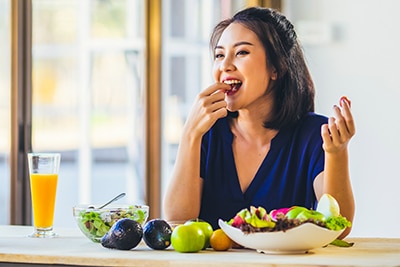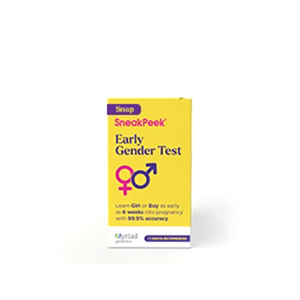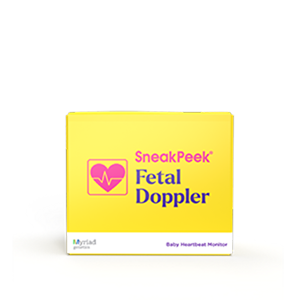Published on April 3rd, 2022 and Updated on April 11th, 2024
Check out SneakPeek Gender Test to find out your baby’s gender as early as 6 weeks at over 99% accuracy!
You’re trying low-impact workouts. You’re tracking ovulation like a pro. You’re even getting eight hours of sleep every night (a miracle, to say the least). Yet somehow, that pregnancy test keeps coming up negative.
One important factor you might be missing is an implantation-friendly fertility diet. To kickstart a pregnancy, your egg needs to be fertilized and then successfully attach to your uterine wall in a process called implantation. A well-balanced and nutritious diet can support this crucial connection.
If you’re just starting your mission for successful implantation, SneakPeek can help. We’ve compiled a list of fertility-boosting foods, from blueberries to oily fish, to nourish your body and enhance your chances of successful implantation and pregnancy.
What is implantation?
First things first: before filling your plate, let’s discuss an important question. What exactly is implantation?
After conception, your fertilized egg will seek a secure landing pad on your uterine lining. This action tells your body, “Hey, we’re pregnant!” and releases a cascade of hormones, including human chorionic gonadotropin, which stops your period and triggers positive results on pregnancy tests. Embryo implantation also lets the embryo begin to absorb vital nutrients from your body and grow.
But when does implantation occur? For a picture of this timeline, here’s a breakdown of the first days of pregnancy:
- Fertilization (0 to 1 day) – Every month, your body releases a mature egg into one of your fallopian tubes. Once there, the egg has a 24-hour fertilization window. If a sperm fertilizes the egg during that timeframe, then voila! You have a fertilized egg-turned-zygote.
- Cell division (1 to 7 days) – Over the next week, your little zygote gets busy. This cell rapidly divides into a multi-cell blastocyst. Simultaneously, the blastocysts travels down the fallopian tube toward the uterus.
- Implantation (8 to 9 days) – It’s the moment the uterus has been waiting for. Hopefully, the blastocyst will burrow into the uterine lining (also called the endometrium). If it successfully implants, then congrats! You’re cruising down first trimester lane. If not, the embryo will leave with your next period.
You might think implantation is a sure thing after fertilization, but in fact, about 60% of fertilized embryos don’t make it to this stage. To increase your body’s chances, a healthy diet is one of the best places to start.
What is an implantation-friendly diet?
An implantation-friendly diet is a diet that encourages your fertilized egg to attach to the lining of your uterus and make a home there for the next 9 months.
Every month, the hormone progesterone thickens your uterine lining to prepare for any fertilized eggs. However, anything from stress to poor nutrition can affect this hormonal process, lowering the chances of implantation. This is where a pro-implantation diet can lend a helping hand—or rather, a friendly fork.
Whether you’re a vegan or an omnivore, every implantation-friendly diet will support these healthy initiatives:
- Fulfilling caloric needs
- Balancing macronutrients (carbs, fats, & proteins)
- Replenishing micronutrients (vitamins & minerals)
- Supporting female hormones
- Emphasizing natural, unprocessed foods
Ready to dig in? Let’s discuss some foods that can encourage implantation.
Foods & Nutrients to Boost Implantation
Overall, a balanced plate with whole foods will help your embryo stick the landing. However, there are a few key nutrients and foods that really turn your womb into a happy home.
From boosting progesterone to lowering inflammation, these foods and nutrients are your top tasty aides for implantation.
#1 Citrus Fruits
For a thick and fertile uterine lining, you need a diet that supports progesterone levels. Fortunately, citrus fruits that are rich in vitamin C can help boost progesterone (and more).
Medical professionals have long recommended vitamin C to women in IVF treatment, or in vitro fertilization. Research shows that vitamin C significantly raises progesterone, with daily supplementation elevating levels by 77%.
Most women can reap their daily needs and improve their implantation likelihood from a diet that features citrus fruits such as:
- Oranges
- Grapefruits
- Strawberries
- Lemons
- Kiwi
#3 Legumes
Looking for another way to boost your progesterone levels? Look no further than legumes.
Legumes—such as chickpeas, lentils, and beans—are packed with zinc, an often overlooked fertility mineral that can help pump up your progesterone levels. This mineral can also reduce early miscarriage rates. However, more than 1 out of 10 Americans are at risk for zinc deficiency.
To ensure you’re getting enough zinc, try adding more legumes to your diet with options like:
- Lentil soup
- Black bean burgers
- Roasted chickpea salad
- Falafel
#3 Leafy Greens
Your mom was right—eat your greens!
Fibrous and chock-full of nutrients, leafy greens are one of the best foods anyone can eat. Women hoping to conceive can also benefit from their calcium, vitamin C, iron, and folate. Research suggests that folate especially aids fertility, showing higher consumption correlating with higher rates of implantation, clinical pregnancy, and live birth rates.
From salads to smoothies, you can get that green on your plate (or in your glass) with folate-rich varieties like:
- Spinach
- Romaine lettuce
- Mustard greens
- Turnip greens
- Swiss chard
#4 Salmon
Salmon is often touted as a heart-healthy meat alternative due to its high levels of omega-3 fatty acids. While omega-3s are generally known for their incredible anti-inflammatory and cardiovascular health benefits, their properties can also help your body prepare for implantation.
In fact, one study found that women between 30 to 44 years old who took omega-3 supplements were nearly twice as likely to get pregnant on their own.
Luckily, omega-3-packed-salmon is more delicious than a supplement and can be prepared in a variety of ways. To double down on your implantation support, consider baking your salmon with vitamin C-rich lemon slices.
Not a fan of salmon? You can also load up on your omega-3s with:
- Mackerel
- Sardines
- Seaweed
- Flaxseeds
- Chia seeds
#5 Berries
That’s right—as a berry, strawberries are hitting this list twice. That’s because this sweet snack not only boasts high levels of vitamin C, but also significant amounts of antioxidants. In fact, strawberries, raspberries, and blueberries are all packed with implantation-supporting antioxidants.
What exactly are antioxidants and why are they important?
Generally speaking, antioxidants are nature’s fountain of youth. These plant-based nutrients attack pesky free radicals—unstable atoms that age the body and lower fertility.
From smoking to poor nutrition, free radicals can come from a variety of factors. The more exposure, the more likely you’ll face fertility issues. Luckily, antioxidants can prevent (and even reverse) free radical damage. In fact, the American Pregnancy Association reports that foods rich in antioxidants can boost egg health and progesterone levels. One study even found that antioxidant supplements significantly improved implantation rates in mice.
To ensure you’re supporting your conception efforts with these powerful nutrients, consider snacking on fresh berries, adding berries to cereal or yogurt, or blending berries into a nutritious smoothie.
#6 Beets
Don’t forget the humble yet mighty beet. Medical professionals especially recommend this violet vegetable to IVF patients for its implantation-boosting powers.
Beets are naturally high in nitric oxide. This gaseous molecule dilates blood vessels, increasing the flow of nutrient-rich blood towards your uterus. The result? A thicker, more fertile healthy uterine lining for implantation. One IVF study even found that women who consumed a beetroot juice mixture daily had significantly higher implantation and clinical pregnancy rates.
Need more reasons to go purple? Beets and their greens also provide incredible health benefits, with pregnancy-friendly nutrients like:
- Folate
- Vitamin A
- Vitamin C
- Iron
- Calcium
#7 Seeds and Nuts
What do sunflower seeds, almonds, and peanuts all have in common? It’s not that they provide a salty snack to munch on during baseball games or days at the beach. Rather, it’s their impressive levels of vitamin E. And vitamin E isn’t just for glowing skin—this vitamin plays an important role in boosting progesterone levels and preparing your uterus for implantation.
An antioxidant and fat-soluble nutrient, vitamin E both increases progesterone and blood flow to the corpus luteum (a hormonal sac in the ovaries that regulates fertility). One study showed that supplementing with this nutrient increased progesterone in 67% of patients.
For optimal absorption, consider adding these vitamin E-xcellent foods to your pregnancy plate:
- Sunflower seeds
- Almonds
- Almond milk
- Dry-roasted peanuts
- Natural peanut butter
- Pine nuts
Recipe & Meal Ideas
Embarking on the journey of enhancing your fertility and supporting implantation is not only about what you eat but also how you savor every bite. In this section, we bring you a few delectable recipes and meal ideas meticulously crafted to harness the power of implantation-supporting foods.
Nourishing Lentil and Chickpea Curry
Ingredients:
- Lentils
- Chickpeas
- Fresh Spinach
- Ripe Tomatoes
- Aromatic Curry Spices
Instructions:
- Begin by cooking lentils and chickpeas to perfection, ensuring they are tender and flavorful.
- Incorporate fresh spinach and ripe tomatoes into the mix, infusing the curry with vibrant colors and essential nutrients.
- Season the dish with a blend of aromatic curry spices, adjusting the flavors to your liking.
This flavorful curry not only satisfies your palate but also supports implantation by providing essential nutrients like zinc, essential for progesterone levels, and folate, known to enhance fertility. Enjoy this hearty and fertility-boosting lentil and chickpea curry as a delicious addition to your implantation-friendly diet.
Omega-3 Enriched Lemon-Dill Salmon
Ingredients:
- Fresh Salmon Fillet
- Slices of Zesty Lemon
- Fragrant Fresh Dill
Instructions:
- Start with a fresh salmon fillet, a canvas ready to be adorned with flavors.
- Place slices of zesty lemon atop the salmon, infusing it with a burst of citrus freshness.
- Generously sprinkle fragrant fresh dill over the fillet, allowing its aromatic essence to infuse the fish.
- Bake the salmon to perfection, ensuring it’s flaky and succulent.
This delectable dish not only tantalizes your taste buds but also supports implantation. Omega-3 fatty acids, abundant in salmon, are known to aid in preparing the body for successful implantation. Enjoy this omega-3 enriched lemon-dill salmon as a flavorful addition to your implantation-friendly diet.
Lifestyle Tips
In your journey towards successful implantation, it’s not only about the foods you eat but also the way you nurture your body and mind. In this section, we offer practical lifestyle tips that encompass stress reduction techniques, low-impact exercises, and essential sleep hygiene practices.
Now, let’s delve into these valuable lifestyle tips:
Stress Reduction: Cultivate Serenity
Incorporate serenity into your daily life to reduce stress levels, creating a more conducive environment for successful implantation. High levels of stress can lead to hormonal changes that negatively impact fertility. Consider the following stress-reduction techniques:
- Mindfulness Meditation: Dedicate a few minutes each day to mindfulness meditation. Focus on your breath and let go of worries and stressors.
- Yoga Sessions: Engage in yoga sessions that not only enhance physical flexibility but also provide mental relaxation and stress relief.
- Deep Breathing Exercises: Practice deep breathing exercises to calm your nervous system and reduce anxiety.
Exercise: Embrace Low-Impact Activities
Embracing low-impact exercises not only helps maintain a healthy weight but also improves circulation, which can support implantation. Here are some low-impact exercise recommendations:
- Leisurely Walks: Take leisurely walks in your favorite natural settings to clear your mind and promote physical well-being.
- Swimming: Engage in swimming sessions, a gentle yet effective way to stay active and relieve stress.
- Prenatal Yoga: Consider practicing prenatal yoga, which not only promotes flexibility but also provides relaxation and emotional balance.
Sleep Hygiene: Prioritize Restful Nights
Prioritizing restful nights by adopting good sleep hygiene practices is essential for both your general well-being and implantation. Follow these sleep hygiene recommendations:
- 7-9 Hours of Sleep: Aim for 7-9 hours of quality sleep each night to promote physical and emotional health.
- Bedtime Rituals: Establish calming bedtime rituals such as reading a book, taking a warm bath, or practicing relaxation techniques.
- Screen-Free Sleep Environment: Avoid electronic screens before bedtime to ensure a peaceful and uninterrupted night’s sleep.
Foods to Avoid During Implantation
With the “Nice” food list comes the “Naughty” food list. Or, more accurately, the “Limit” food list.
In both men and women, diet impacts fertility rates. Meta-research shows the more processed and less nutritious your diet, the less fertile you tend to be. You can still have your treats (no need to give up that scoop of ice cream), but consider skipping these nutrient-stripped foods when grocery shopping:
- Processed meats – The saturated fat, nitrate, and sodium content of processed meats spells out lower fertility. Current research has found that high consumption of these meat products—bacon, hot dogs, sausage—correlated with lower sperm counts and higher ovulation disorder rates. Replacing processed meats with vegetable proteins or lean poultry could reduce these risks.
- High-glycemic foods – Sugars, white flours, and white grains—these low-fiber carbohydrates all contribute to blood sugar spikes, ranking high on the Glycemic Index. Women who regularly consume high-glycemic foods have lower fertility rates, usually due to increased obesity and insulin resistance. When getting pregnant, consider replacing any white grains with whole grains or cutting back on added sugars.
- Alcohol – For couples trying to conceive, alcohol can be a fertility killer. For women, one 2017 study showed a strong correlation between high alcohol consumption and low conception rates. For men, heavy alcohol consumption (more than 15 drinks per week) correlates with lower testosterone, sperm counts, and testicle size.
To learn more about foods to avoid before and during pregnancy, check out our blog posts answering questions like, “can you have hot dogs while pregnant,” “can you have caffeine while pregnant,” and “can you have blue cheese while pregnant?”
Take a Bite of the Future with SneakPeek
Whether conceiving through natural means or IVF, it’s never too late to start eating for two. Load up on nature’s best, and your little one will have a healthy and happy home for the next nine months.
Can’t wait to meet your growing baby? We don’t blame you! That’s why we created the ultimate look into the future—the SneakPeek At-Home Early Gender Prediction Test, which can let you know if you’re having a boy or girl at just 6 weeks into pregnancy.
Trusted by over 1 million moms, our at-home fetal sex test is clinically proven to be over 99% accurate1. Plus, with our innovative pain-free sample collector, SneakPeek Snap, the process is as easy as sample-and-ship. It’s no wonder why SneakPeek Test is the #1 OBGYN-recommended at-home Gender Blood Test.
Once your baby successfully implants, order SneakPeek Gender and meet your little one sooner.
Editorial Policy
At SneakPeek, our commitment is to provide accurate, up-to-date, and reliable information to empower our readers. Our content is thoroughly researched, reviewed by medical experts, and fact-checked to ensure its credibility. We prioritize the well-being and education of our readers, and our editorial policy adheres to the highest standards of integrity and accuracy in all our articles.
This post has been reviewed for accuracy by the following medical professional:
Katie Smith is a seasoned Certified Nurse Midwife and a nurturing mother to six children, offering a unique blend of professional expertise and personal experience. She is the founder of Birth Your Way Midwifery and Women’s Wellness Center in Bay County, Florida. Katie's comprehensive approach to care is informed by her hands-on experience in motherhood and her passion for empowering women through their birthing journey. Her dedication extends beyond her center as she actively engages in community wellness and family health education.
Sources:
- American Pregnancy Association. Boost Your Fertility with Supplements. https://americanpregnancy.org/getting-pregnant/infertility/boost-your-fertility/
- ASRM. Beetroot, watermelon and ginger juice supplementation may increase the clinical outcomes of intracytoplasmic sperm injection cycles. https://www.fertstert.org/article/S0015-0282(19)31942-9/fulltext
- ASRM. Omega-3 fatty acid supplementation and fecundability. https://www.fertstert.org/article/S0015-0282(19)30810-6/fulltext
- Journal of Ovarian Research. Luteal blood flow and luteal function. https://ovarianresearch.biomedcentral.com/articles/10.1186/1757-2215-2-1
- CDC – Sleep Hygiene. https://www.cdc.gov/sleep/about_sleep/sleep_hygiene.html
- Cleveland Clinic. Omega-3 Fatty Acids. https://my.clevelandclinic.org/health/articles/17290-omega-3-fatty-acids
- Frontiers in Public Health. The Influence of Diet on Fertility and the Implications for Public Health Nutrition in the United States. https://www.ncbi.nlm.nih.gov/pmc/articles/PMC6079277/
- Healthline. Does Alcohol Kill Sperm? And Other Fertility Facts. https://www.healthline.com/health/does-alcohol-kill-sperm-2
- Healthline. What Are the Signs That Implantation Has Occurred? https://www.healthline.com/health/implantation-signs
- Human Reproduction Journal. The association between alcohol intake and fecundability during menstrual cycle phases. https://academic.oup.com/humrep/article/36/9/2538/6294415?login=false
- JGS Lifecare – Easy Does It: Heart-Friendly Low-Impact Exercises. https://jgslifecare.org/news/easy-does-it-heart-friendly-low-impact-exercises/
- Medical News Today. What to know about endometrial thickness. https://www.medicalnewstoday.com/articles/327036
- NCBI. Dietary Folate and Reproductive Success Among Women Undergoing Assisted
- Reproduction. https://www.ncbi.nlm.nih.gov/pmc/articles/PMC4172634/
- NIH. A prospective study of dairy foods intake and anovulatory infertility. https://pubmed.ncbi.nlm.nih.gov/17329264/
- NIH. Antioxidants improve IVF outcome and subsequent embryo development in the mouse. https://pubmed.ncbi.nlm.nih.gov/29136144/
- NIH. Dietary patterns, foods and nutrients in male fertility parameters and fecundability: a systematic review of observational studies. https://pubmed.ncbi.nlm.nih.gov/28333357/
- NIH. Effects of ascorbic acid supplementation on serum progesterone levels in patients with a luteal phase defect. https://pubmed.ncbi.nlm.nih.gov/12909517/
- NIH. Folate. https://ods.od.nih.gov/factsheets/Folate-HealthProfessional/
- NIH. Glycemic load, dietary fiber, and added sugar and fecundability in 2 preconception cohorts. https://pubmed.ncbi.nlm.nih.gov/31901163/
- NIH. Processed meat intake is unfavorably and fish intake favorably associated with semen quality indicators among men attending a fertility clinic. https://pubmed.ncbi.nlm.nih.gov/24850626/
- Oregon State University. Zinc deficiencies a global concern. https://today.oregonstate.edu/archives/2009/sep/zinc-deficiencies-global-concern
- Parents Magazine. TTC? Load Up on These Vitamins to Increase Fertility. https://www.parents.com/getting-pregnant/fertility/best-vitamins-and-minerals-to-aid-conception/
- The Journal of Nutrition. Processed Meat Intake Is Unfavorably and Fish Intake Favorably Associated with Semen Quality Indicators among Men Attending a Fertility Clinic. https://www.ncbi.nlm.nih.gov/pmc/articles/PMC4056648/
- University of California San Francisco. Conception: How It Works.
- https://www.ucsfhealth.org/education/conception-how-it-works
- VeryWellMind. Stages of Prenatal Development. https://www.verywellmind.com/stages-of-prenatal-development-2795073
- VFPPharmacyGroup – Stress and Fertility: How Stress Affects Implantation and Pregnancy. https://blog.vfppharmacygroup.com/stress-and-fertility-how-stress-affects-implantation-and-pregnancy
- Wellbeing Magazine. Beetroot – The new fertility hero. https://wellbeingmagazine.com/health/beetroot-new-fertility-hero/

Shop Our Products
SneakPeek aims to provide the most accurate and up-to-date information to help our readers make informed decisions regarding their health before, during, and after pregnancy. This article was written based upon trusted scientific research studies and/or articles. Credible information sources for this article are cited and hyperlinked.






